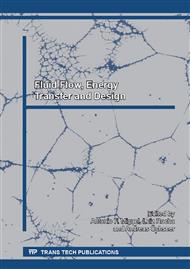p.3
p.9
p.20
p.27
p.40
p.51
p.58
p.64
p.71
Numerical Analysis of Heat Transfer of a Flow Confined by Wire Screen in Lithium Bromide Absorption Process
Abstract:
The present study deals with the numerical analysis of heat transfer inside a lithium bromide solution flowing down between finely meshed plastic wire screens. These screens confine the flow through capillary action while allowing the water vapor transfer inside an innovative absorber technology. The complex menisci shape formed on the confinement grid level, where the surface tension forces are of first importance, are reconstructed by a volume of fluid (VOF) model. A continuum surface force model is used to account for the surface tension force. A static contact angle is used to define the wall adhesion. A new algorithm, consisting to set an unique constant temperature at the liquid/vapour interface and to determine the evolution of heat transfer characteristics over the simulation domain, has been implemented and validated by analytical solutions. A parametric study has been conducted to determine the effect of the inlet velocity and the geometrical parameters (wire diameter and the number of divisions).
Info:
Periodical:
Pages:
40-50
Citation:
Online since:
January 2014
Price:
Сopyright:
© 2014 Trans Tech Publications Ltd. All Rights Reserved
Share:
Citation:


